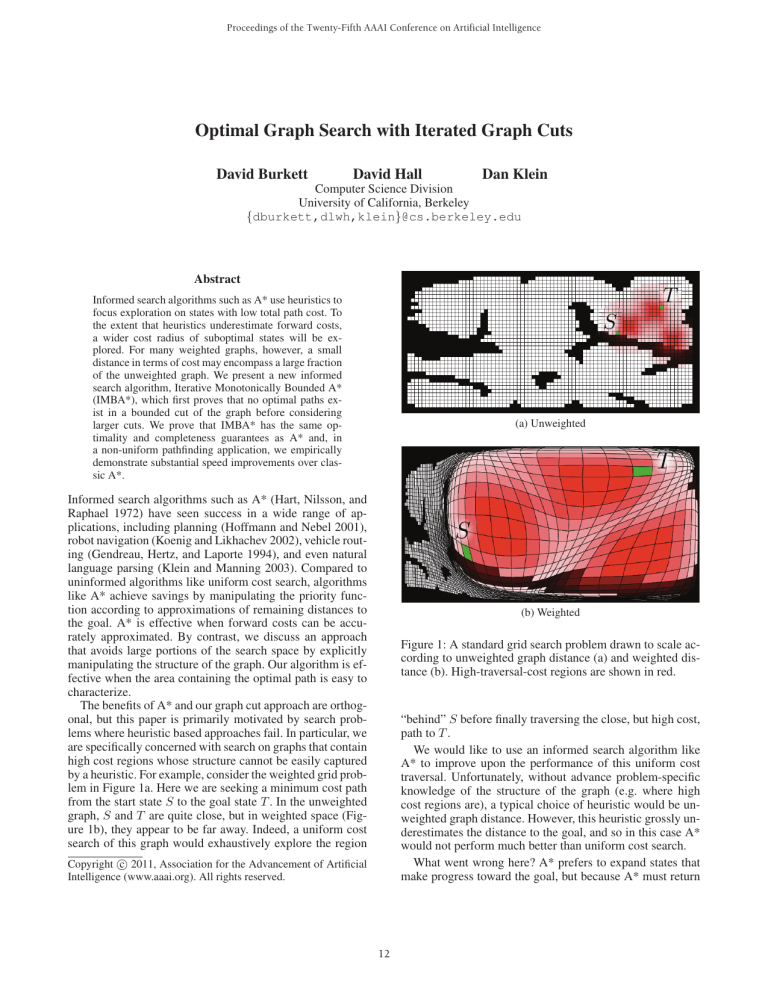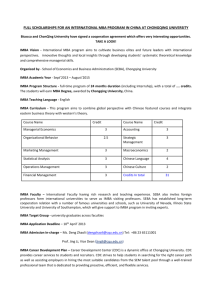
Proceedings of the Twenty-Fifth AAAI Conference on Artificial Intelligence
Optimal Graph Search with Iterated Graph Cuts
David Burkett
David Hall
Dan Klein
Computer Science Division
University of California, Berkeley
{dburkett,dlwh,klein}@cs.berkeley.edu
Abstract
Informed search algorithms such as A* use heuristics to
focus exploration on states with low total path cost. To
the extent that heuristics underestimate forward costs,
a wider cost radius of suboptimal states will be explored. For many weighted graphs, however, a small
distance in terms of cost may encompass a large fraction
of the unweighted graph. We present a new informed
search algorithm, Iterative Monotonically Bounded A*
(IMBA*), which first proves that no optimal paths exist in a bounded cut of the graph before considering
larger cuts. We prove that IMBA* has the same optimality and completeness guarantees as A* and, in
a non-uniform pathfinding application, we empirically
demonstrate substantial speed improvements over classic A*.
S
T
(a) Unweighted
T
Informed search algorithms such as A* (Hart, Nilsson, and
Raphael 1972) have seen success in a wide range of applications, including planning (Hoffmann and Nebel 2001),
robot navigation (Koenig and Likhachev 2002), vehicle routing (Gendreau, Hertz, and Laporte 1994), and even natural
language parsing (Klein and Manning 2003). Compared to
uninformed algorithms like uniform cost search, algorithms
like A* achieve savings by manipulating the priority function according to approximations of remaining distances to
the goal. A* is effective when forward costs can be accurately approximated. By contrast, we discuss an approach
that avoids large portions of the search space by explicitly
manipulating the structure of the graph. Our algorithm is effective when the area containing the optimal path is easy to
characterize.
The benefits of A* and our graph cut approach are orthogonal, but this paper is primarily motivated by search problems where heuristic based approaches fail. In particular, we
are specifically concerned with search on graphs that contain
high cost regions whose structure cannot be easily captured
by a heuristic. For example, consider the weighted grid problem in Figure 1a. Here we are seeking a minimum cost path
from the start state S to the goal state T . In the unweighted
graph, S and T are quite close, but in weighted space (Figure 1b), they appear to be far away. Indeed, a uniform cost
search of this graph would exhaustively explore the region
S
(b) Weighted
Figure 1: A standard grid search problem drawn to scale according to unweighted graph distance (a) and weighted distance (b). High-traversal-cost regions are shown in red.
“behind” S before finally traversing the close, but high cost,
path to T .
We would like to use an informed search algorithm like
A* to improve upon the performance of this uniform cost
traversal. Unfortunately, without advance problem-specific
knowledge of the structure of the graph (e.g. where high
cost regions are), a typical choice of heuristic would be unweighted graph distance. However, this heuristic grossly underestimates the distance to the goal, and so in this case A*
would not perform much better than uniform cost search.
What went wrong here? A* prefers to expand states that
make progress toward the goal, but because A* must return
c 2011, Association for the Advancement of Artificial
Copyright Intelligence (www.aaai.org). All rights reserved.
12
optimal solutions, it must be cautious: it might be the case
that there is some minimum cost path that goes exclusively
through the low cost region, and so A* tolerates some deviation from making progress towards the goal (in terms of
heuristic cost) in order to possibly find a lower cost path.
However, as implementors we know—or at least
suspect—that these deviations will not actually find the optimal path, and that any path to the goal will likely not stray
too far from the start and goal states. A naive solution would
be to simply restrict the search space to those states that are
somehow “near” either the start or the goal. We could define a cut of the graph that includes both the start and the
goal, and attempt to find a path that remains inside that cut.
Of course, if we simply delete states and edges, we might
remove the optimal path or even all paths. In the latter case
we could simply take larger and larger cuts until we find a
path, but the former issue is more difficult to address: when
we find a path in a cut how do we know that it is optimal in
the full graph?
S
T
(a) Grid Search Problem
IMBA*
To answer this question, we introduce Iterative Monotonically Bounded A* (IMBA*). The core improvement to the
naive graph-cut approach above is that each cut is repaired
in such a way that the connectivity of the original graph is
preserved: for all states in the cut with a path between them
in the original graph, there is some path between them in the
repaired cut graph with cost less than or equal to the path in
the original graph. We formalize this notion later, but first
we present an execution of the algorithm in a small grid.
Consider the search problem in Figure 2a. As in Figure 1,
the optimal path from the start to the goal must pass through
a high cost region. Moreover, the optimal path never strays
far from a small area around the start and the goal. Therefore, we place a bet that the optimal path will not leave the
area marked by a blue rectangle in Figure 1b. To ensure that
a lower bound on the optimal path is preserved, we add or
adjust edges between the states on the border (highlighted in
purple) between the cut and the exterior of the graph. Here,
we make all of these new edge costs 1, since that is the minimum cost between any two states on the original graph. In
general, we only add edges that create paths of lower cost
than existing paths through the exterior of the graph.
Given this repaired cut, we simply find the shortest path
from S to T in this graph, shown in Figure 1b. Because this
path goes through the border, it could be the case that the
optimal path in the full graph lies outside this cut, as indeed
it does. Therefore, we relax the cut, taking a larger portion
of the graph and repairing the cut as before (Figure 1c). Now
the shortest path in this graph lies entirely on the interior of
the cut. Therefore, we know that the path is optimal in the
whole graph, because any path that goes through the exterior of the graph has some path that is cheaper that passes
through the border region.
Thus, our algorithm has managed to limit its exploration
to a relatively small fraction of the search space, whereas
standard A* in this case explores 94% of the grid.
(b) First Cut
(c) Second Cut
Figure 2: A full grid search problem (a) and two successive
searches, restricted to a smaller (b) and slightly larger (c)
region of the grid. The boundary of each restricted set, where
all obstacles are removed and traversal costs are reduced to
1, is shaded purple. Start and goal states, and the optimal
paths between them, are shown in green.
13
Algorithm 1 IMBA*
Require: A sequence of cuts Ci
Require: A start state S and a goal state T
Require: An optimal search procedure and a repair procedure
for i = 1 · · · do
Ci+ ← repair(Ci )
path,cost ← search(Ci+ , S, T )
if cost = ∞ then {no path exists}
return path,cost
else if ¬∀n ∈ path.n ∈
/ Bi then {optimal path found}
return path,cost
end if
end for
Figure 4: A search problem with no feasible solution. Standard algorithms such as A* would expand the entire reachable component of the graph in this instance, while IMBA*
will terminate after trying the outlined cut.
through the border Bi , then that path is also optimal in G,
and it can be returned. Otherwise, we proceed to the next cut.
Since the last cut is equal to the entire graph, the algorithm
will terminate.
It is worth stressing that—although we term our algorithm
IMBA*—it is actually not required that the inner search procedure be A*. Indeed, it can be any optimal and complete
search algorithm. Thus, any of the many variants of A*—
e.g. Iterative Deepening A* (Korf 1985)—or even uniform
cost search can be used.
Algorithm
Formally, define a search problem on a weighted graph G
with a set of states V and edges E. We seek a path from the
start state S to goal state T .
Now define a sequence of N cuts {S, T } ⊆ C1 ⊂ C2 ⊂
· · · ⊂ C N = V .1 The exterior Xi of a cut is G\Ci . The
border Bi ⊆ Ci of a cut is the set of states that share at least
one edge with a state in Xi (the purple edges in Figure 3a). In
a grid, this border really will appear to be a visible “border”
of the cut, though in a more general graph it might not be.
Given a cut Ci and its border Bi we define a repaired cut
Ci+ as any graph with the following properties:
Correctness
In this section we prove that IMBA* is both complete and
optimal; that is, that it always returns a path if there is one,
and that it always returns the best possible path. The proofs
are straightforward.
Ci+
is a superset
1. Node Preservation: The set of states in
of the states in Ci .
2. Edge Preservation: Any edge directly connecting states
in Ci is preserved.
3. Interior Maintenance: No edges may be added that directly connect states that lie on the interior Ci \Bi of the
graph.
4. Border Optimism: If there exists a path in G connecting
two states in Bi that passes through Xi with cost c, then
there must exist a path in Ci+ between those same states
with cost c ≤ c.
These properties ensure that all paths in the original graph
have some analog in the cut graph of the same or cheaper
cost. We will use these properties to prove the correctness of
our algorithm.
With the notation above, the algorithm is quite easily
specified (Algorithm 1). Essentially, we iterate through each
cut Ci of the graph, repair that cut to form Ci+ , and run an
optimal and complete search algorithm from the start state
to the goal state in Ci+ . If the search procedure does not find
any path in a cut, then the entire algorithm can terminate,
since there must be no path at all in the original graph. That
is, IMBA* can “fail fast” without exploring the entire state
space, something that typical A* cannot do. (See Figure 4
for an example.) If instead a path is found that does not pass
Proposition 1. IMBA* is complete.
Proof. At some point the succession of cuts Ci · · · CN will
contain any path (by construction) in the underlying graph,
since the cuts must grow towards including all states. Thus,
the only concern is that IMBA* aborts early, which it can do
for one of two reasons: either it returns no path, or it returns
a path that does not correspond to some path in the full graph
G.
First, assume that in some cut Ci+ , there is no path from
S to T , but there is such a path in the entire graph G. Since
Ci+ contains all paths that lie entirely within Ci (Node and
Edge Preservation), this path must both exit and enter the
exterior Xi of the graph, and therefore must pass through
at least two boundary states. However, by construction, Ci+
has a path between those two states (Path Optimism), meaning that there must be some path in Ci+ . Thus, we have a
contradiction.
To handle the second case, now assume that IMBA* returns a path that does not exist in the true graph. To do
so, it would have to use an edge that does not exist in the
underlying graph G. Since no edges can be added entirely
within the interior of the cut (Interior Maintenance), the path
must touch a border state, contradicting our assumption that
IMBA* terminated early.
1
It is actually not necessary but merely sufficient for the cuts to
be subsets of each other. For clarity, we do not attempt a definition
of the exact conditions.
14
Ci+
S
Ci
T
Xi
T
T
T
S
S
S
Bi
Bi
(a) Graph Cut
Ci+
Ci+
(b) Extra Node Repair
Bi
(c) All Edges Repair
(d) Natural Edges Repair
Figure 3: A cut of a search graph (a) that leaves no path from S to T , and three different methods of repairing the cut (b-d).
Edges introduced as part of the repair are shown in blue.
grow too quickly, then the algorithm may perform no better
than standard A*. In our particular application, we found
that growing the bounding boxes by 4x (doubling both their
width and their height) was effective.
Finally, one has to choose a method for repairing a cut Ci
into Ci+ . We describe three simple methods, though more
complicated methods may fare better, depending on the application. Consider the graph in Figure 3a. The simplest
method is to treat the exterior of the graph Xi as a single
state, and add edges to each boundary state into and out of
Xi as appropriate. (See Figure 3b.) Alternatively, one can
add edges directly between all boundary states, as in Figure 3c. Depending on the graph, both of these methods may
exhibit branching factors that are much too high, as there
is at least one state that touches every state on the border.
A third approach—especially suitable for grids—is the one
illustrated in Figure 3d. Here, we add arcs that are logical neighbors even if they are not connected in the original
graph. For all of these methods, the weights of the edges can
be set to 0, though any weights that preserve the lower bound
property work and higher weights will perform better.2
Proposition 2. IMBA* is optimal.
Proof. Suppose that the algorithm returned a suboptimal
path when searching in some cut Ci+ . By our requirement
on the underlying search procedure, any path found in Ci+
must be optimal for Ci+ . Moreover, from above we know
that this path must correspond to some path in the true graph
and therefore consist only of edges in the true graph. (Otherwise, it would have to pass through a border state, and
IMBA* would not return it.) This path has cost c which is
less than all other path costs in Ci+ . We also know that the
true optimal path (with cost c∗ ) does not lie entirely within
the cut, because otherwise the underlying search would have
found it. Thus, this path has some corresponding path in
the repaired cut graph that passes through the border region with cost c ≤ c∗ (Path Optimism). But this means that
c ≤ c∗ < c, contradicting our assumption that c is the cost
of the optimal path in Ci+ .
Defining and Repairing Cuts
We have largely left open two key pieces of the algorithm:
defining and repairing cuts. In this section we discuss a
few approaches and considerations when specifying these.
Largely, these points are guidelines, and it will fall to the
implementor to find and test cuts that are well-suited to the
particular domain.
Defining the cuts themselves typically requires a certain
amount of domain knowledge. In the case of pathing problems, a simple bounding box construction around the start
and goal state seems to work well, as we’ve shown in the
examples. In more general graphs, cutting based on a measure of graph distance from the start and goal state might be
appropriate. One simple extension is to take a cut that includes an unweighted shortest path in the underlying graph.
Areas around this path may contain the optimal path, though
of course this will depend on the particular search problem.
Defining a good sequence of cuts is perhaps the trickiest
aspect of the algorithm. If the cuts are too tight or grow too
slowly, then IMBA* will waste a significant amount of time
re-searching over the same area. If, on the other hand, they
Related Work
There are other approaches which exploit graph alteration,
if in different ways, to improve speed. For example, Hierarchical A* uses a sequence of carefully-defined graph
projections to define a cascade of search problems, where
the solution for one problem is used as the heuristic for
the next (Holte et al. 1996). Another approach involves
the definition and composition of abstraction operators
that typically correspond to subproblems of the original
task (Helmert, Haslum, and Hoffmann 2007; Yang et al.
2008; Katz and Domshlak 2010). These approches differ
from ours in two major ways. First, they both require a natural decomposition of the graph into subtasks or subregions,
which may not always be feasible. Second, they are both
2
While IMBA* does not require any further properties, the
choice of edge weights may interact with the heuristic used for
the inner A* procedure. Namely, one must take care to preserve
consistency.
15
(a) Example Search Problem
(b) Nodes Expanded by A*
(c) Nodes Expanded by IMBA*
Figure 5: An example search problem from our evaluation set, including the optimal path from S to T . In (b) and (c), the nodes
highlighted in blue are those expanded by A* and by IMBA*, respectively.
methods for computing improved heuristics, with the final
search still performed on the original graph. However, in
search problems where they apply, they could be used as part
of IMBA*’s inner A* search, possibly stacking the benefits
of each approach.
Another class of related algorithms are those that use a
modified search rather than an improved heuristic to boost
efficiency. Of these, the ones most relevant for the problems that motivate IMBA* are the bidirectional variants of
A* (Pohl 1969). Like IMBA*, these algorithms explore the
expensive points around both start and goal quickly, avoiding the problems characteristic of A* in these environments.
However, straightforward implementations do not preserve
the optimality guarantees of A*. Instead, one must run the
search algorithm until a specific condition is reached (Kaindl
and Kainz 1997); merely connecting the two fringes is
not sufficient for optimality. In the next section, we show
that IMBA* is faster than even the non-optimal variant of
bidirectional A* in threat-aware pathfinding scenarios commonly seen in real-time strategy games.
Algorithm
A*
Bi A* (Opt)
Bi A* (Fast)
IMBA*
Time
(ms)
414
923
144
83
Nodes
Expanded
110,064
214,078
36,276
23,806
Num
Cuts
1.0
1.0
1.0
2.2
Path
Cost
1.000
1.000
1.005
1.000
Table 1: Empirical speed results for A* vs IMBA*. All values are averaged per search problem. Path costs are scaled
such that optimal paths have cost 1.0. Bi A* refers to an
implementation of the algorithm of Kaindl and Kainz 1997,
which has optimal and fast variants.
created scenarios based on a standard StarCraft map.3 We
show an example in Figure 5a. Though StarCraft allows
nearly arbitrary movement directions, we restricted these
scenarios to an 8-connect grid at the finest level of terrain,
giving 196,608 positions, 23% of which were impassable.
We compared IMBA* to three baselines. First was our implementation of A*. (IMBA* calls this implementation as
its inner search procedure.) We also tried two variants of
bidirectional A* (Kaindl and Kainz 1997): one that guarantees an optimal path (Opt), and a suboptimal version that
returns a path as soon as the two fringes intersect (Fast).
We used Euclidean distance as our heuristic. We ran our experiments on a Large Amazon EC2 instance, and averaged
over 100 runs. The results are shown in Table 1. We found
that our implementation of IMBA* was on average 4-5 times
faster than A*, measured both in absolute runtime and total
node expansions.4 For this class of problems, bidirectional
Experiments
The development of our algorithm was motivated by our
need for an efficient pathfinder for an agent we developed
for the AIIDE 2010 StarCraft AI Competition. Our agent
needed to find safe paths to navigate its units into and out
of enemy territory while taking a minimum of damage. The
representation we chose modeled enemy units as soft obstacles, that is, as regions with high cost. Typically, our agent
needed to find fairly short paths in terms of unweighted
graph distance. However, these paths almost always ventured into areas heavily threatened by enemy units.
To simulate these situations, we generated 100 randomly
3
4
16
Available at http://overmind.cs.berkeley.edu/maps.
A node was counted twice if IMBA* expanded it as part of two
tic functions. Our algorithm exploits the intuition that paths
should generally stay close to the start and goal states, in
a way that is sometimes hard to incorporate into the design of admissible and consistent heuristics. We proved that
our algorithm–using graph cuts with the right properties–
preserves the optimality and completeness guarantees of
A*. In simulations reflecting actual pathfinding scenarios,
IMBA* significantly outperformed classical A*.
References
Gendreau, M.; Hertz, A.; and Laporte, G. 1994. A tabu
search heuristic for the vehicle routing problem. Management Science 40(10):pp. 1276–1290.
Hart, P. E.; Nilsson, N. J.; and Raphael, B. 1972. Correction
to “a formal basis for the heuristic determination of minimum cost paths”. SIGART Bull. 28–29.
Helmert, M.; Haslum, P.; and Hoffmann, J. 2007. Flexible
abstraction heuristics for optimal sequential planning. In In
Proc. ICAPS 2007, 176–183.
Hoffmann, J., and Nebel, B. 2001. The ff planning system:
fast plan generation through heuristic search. JAIR 14:253–
302.
Holte, R.; Perez, M.; Zimmer, R. M.; and Macdonald, A. J.
1996. Hierarchical A*: Searching abstraction hierarchies efficiently. In AAAI, 530–535.
Kaindl, H., and Kainz, G. 1997. Bidirectional heuristic
search reconsidered. CoRR.
Katz, M., and Domshlak, C. 2010. Implicit abstraction
heuristics. JAIR 39:51–126.
Klein, D., and Manning, C. 2003. Factored A* search for
models over sequences and trees. In IJCAI, 1246–1251.
Koenig, S., and Likhachev, M. 2002. Improved fast replanning for robot navigation in unknown terrain. In ICRA ’02,
volume 1, 968 – 975.
Korf, R. E. 1985. Depth-first iterative-deepening: An optimal admissible tree search. Artificial Intelligence 27:97–
109.
Pohl, I. S. 1969. Bi-directional and heuristic search in path
problems. Ph.D. Dissertation, Stanford University, Stanford,
CA, USA.
Yang, F.; Culberson, J. C.; Holte, R.; Zahavi, U.; and Felner,
A. 2008. A general theory of additive state space abstractions. JAIR 32:631–662.
Figure 6: The runtime in milliseconds for each search problem, using either A* or IMBA*. Points along the diagonal
represent problems that took the same length of time for both
algorithms. In most cases, IMBA* is quite a bit faster, but
there are a few problems where the search expanded to the
entire grid, and the additional overhead of the earlier cuts
resulted in a slight slowdown for IMBA*.
A* does extremely poorly when forced to return an optimal path, essentially solving the search problems in both directions. When permitted to return early, bidirectional A* is
much faster than A* and exhibits a relatively low degree of
suboptimality, but it is still not as fast as IMBA*, which is
guaranteed to be optimal.
In Figure 5b we depict graphically the state space that A*
explores as compared to IMBA* in Figure 5c. A* expands
all nodes that have f -cost (that is, accumulated backward
cost plus estimated forward cost) less than or equal to the f cost of the goal. IMBA*, on the other hand, explores many
fewer nodes, exploring only those nodes with the same or
lesser f -cost on the narrowest cut provably containing the
optimal path. In fact, in this example neither A* nor IMBA*
significantly benefit from the heuristic at all, exploring almost all possible low-cost nodes. IMBA*, however, does
benefit from using the graph cuts, since the source and goal
nodes are so close to each other.
Of course, our algorithm is not guaranteed to always outperform A*, and so we plotted the time taken by A* versus
IMBA* across these executions in Figure 6. While IMBA* is
usually much faster, there are a handful of search problems
where A* has a slight advantage. The main shortcoming of
these examples is the repeated search that IMBA* performs.
We suspect that it should be possible to reuse some information from earlier cuts to speed computation of later cuts,
though we leave that for future research.
Conclusion
In this paper, we have presented a novel technique for efficiently finding shortest paths in graphs with high cost regions that can not be easily captured by traditional heurissuccessive cuts.
17





